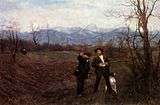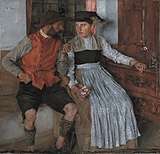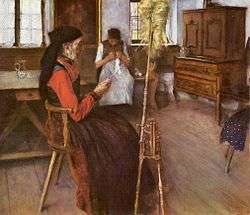Wilhelm Leibl
Wilhelm Maria Hubertus Leibl (October 23, 1844 – December 4, 1900) was a German realist painter of portraits and scenes of peasant life.
Wilhelm Leibl | |
|---|---|
Self-portrait at the age of eighteen | |
| Born | Wilhelm Maria Hubertus Leibl October 23, 1844 |
| Died | December 4, 1900 (aged 56) |
| Nationality | German |
| Occupation | Painter |

Biography
Leibl was born in Cologne, where his father was the director of the Cathedral choir. He was apprenticed to a locksmith before beginning his artistic training with the local painter Hermann Becker in 1861.[1] He entered the Munich Academy in 1864, subsequently studying with several artists including Carl Theodor von Piloty. He set up a group studio in 1869, with Johann Sperl, Theodor Alt, and Rudolf Hirth du Frênes. At about the same time, Gustave Courbet visited Munich to exhibit his work, making a considerable impression on many of the local artists by his demonstrations of alla prima painting directly from nature.[2] Leibl's paintings, which already reflected his admiration for the Dutch old masters, became looser in style, their subjects rendered with thickly brushed paint against dark backgrounds.
Career
In 1869, following Courbet's suggestion,[3] Leibl went to Paris, where he was introduced to Édouard Manet, but was forced to return to Germany in 1870, due to the outbreak of the Franco-Prussian War.[1] In 1873 Leibl left Munich for the isolated Bavarian countryside, where he depicted the local peasants in everyday scenes devoid of sentimentality or anecdote. The sketchlike quality of his earlier paintings was replaced by greater precision and attention to drawing. Living from 1878 to 1882 in Berbling, he painted perhaps his best-known work, the Three Women in Church (Kunsthalle, Hamburg). Its intensely realistic style recalls Hans Holbein in its clarity of definition. During the following years he moved to the town of Bad Aibling and, in 1892, to Kutterling, as his paintings united the disciplined drawing he had adopted in the 1880s with a new delicacy and luminosity.
Leibl painted without preliminary drawing, setting to work directly with color, an approach that has parallels to Impressionism. His commitment to the representation of reality as the eye sees it earned him recognition in his lifetime as the preeminent artist of a group known as the Leibl-Kreis (Leibl Circle) that included, among others, Carl Schuch, Wilhelm Trübner, Otto Scholderer, and Hans Thoma.
During the first half of the 1870s, Leibl executed a series of 19 etchings[4] in a meticulous style. His charcoal drawings are conceived in great masses of light and shadow, blocked in as though he were using a brush and paint.
He visited the Netherlands in 1898, and his work was included in the Berlin Secession exhibition the following year. He died in Würzburg in 1900.[1]
- Selected works
 Wilhelm Leibl and Sperl on the hunt, 1890–1895, oil on canvas, Neue Pinakothek
Wilhelm Leibl and Sperl on the hunt, 1890–1895, oil on canvas, Neue Pinakothek Girl with White Headscarf, c. 1876, oil on panel
Girl with White Headscarf, c. 1876, oil on panel In der Bauernstube, 1890, oil on panel
In der Bauernstube, 1890, oil on panel Die Spinnerin, 1892
Die Spinnerin, 1892 Johann Heinrich Pallenberg, 1871
Johann Heinrich Pallenberg, 1871 Freiherrn von Perfall als Jäger
Freiherrn von Perfall als Jäger Portrait of Rosine Fischler, Gräfin Treuberg, 1878
Portrait of Rosine Fischler, Gräfin Treuberg, 1878 Portrait of a Man, c. 1890
Portrait of a Man, c. 1890- Girl with Black Headscarf, 1879, oil on panel (detail)
 Veterinarian Dr. Reindl in the arbor, c. 1890
Veterinarian Dr. Reindl in the arbor, c. 1890
Notes
- Artist biography in German Masters of the Nineteenth Century, pp. 269–70
- Forster-Hahn 2001, p. 155
- Novotny 1978 p.288
- Novotny 1978, p.289
References
- German Masters of the Nineteenth Century: Paintings and Drawings from the Federal Republic of Germany. Catalogue of an exhibition held at the Metropolitan Museum of Art, New York, 1981. Free download available.
- Forster-Hahn, Françoise (2001). Spirit of an Age: Nineteenth-Century Paintings From the Nationalgalerie, Berlin. London: National Gallery Company. ISBN 1-85709-981-8
- Novotny, Fritz (1978) [1960]. Painting and Sculpture in Europe. The Pelican History of Art. Harmondsworth: Penguin Books. ISBN 014056120X.
- Ruhmer, Eberhard, and Wilhelm Leibl (1984). Der Leibl-Kreis und die reine Malerei. Rosenheim: Rosenheimer Verlagshaus. ISBN 3475524554 (German language)
External links
- German masters of the nineteenth century: paintings and drawings from the Federal Republic of Germany, a full text exhibition catalog from The Metropolitan Museum of Art, which contains material on Wilhelm Leibl (no. 41-43)
| Wikimedia Commons has media related to Wilhelm Leibl. |